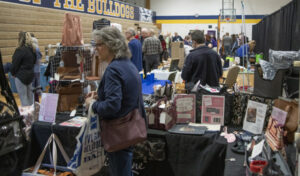
By Jennifer Fairfield
December Featured Product
Poinsettia – ‘Tis the season for poinsettias. I love how beautiful they make the store – and the house – look right now, with all the color combinations that our growers do. They are a simple way to add some bright holiday color to your home right now, and you can keep them for next year, with just a bit of TLC.
Some interesting poinsettia facts from Michigan State Extension:
Poinsettias are native to Mexico, and were first brought to the US in 1828 by Joel Roberts Poinsett (for whom they are named), the first U.S. Ambassador to Mexico.
Poinsettias are part of the Euphorbia Family, and in their native home, are considered a shrub that can grow to as much as 13 feet tall.
In 2010, Michigan ranked 7th nationally in poinsettia production, growing almost 2.4 million plants!
Poinsettias are not poisonous. That doesn’t mean we recommend eating them, though. While not poisonous, some people may be allergic to the milky sap in poinsettias, and small animals can choke on fibrous leaves.
The ideal conditions for poinsettias in your house are bright but indirect sunlight for at least 5 hours, watering when the soil is dry to the touch, and warm – but not hot –temperatures (60° to 70°F).
Along with my bulb planting, I still have lots to get done in my yard and gardens, so I’m counting on the weather holding out for at least the next few days. Here’s what we can be doing this month:
Flowers:
As I mentioned, it’s still possible to get bulbs planted. Take advantage of the fact that the ground is still not frozen to get this done
If you’ve had issues with creatures digging up your tulip bulbs in the past, there are a few things you can do to help prevent this. Here’s a link to some options. There’s also one rather simple option that can help – put your bulbs into a paper bag with some baby powder and shake them up to coat the bulbs with the powder. The odor of the powder can help to throw off the critters.
You can also force bulbs indoors over the winter. There’s nothing like flowers in bloom in your house in late winter to get you in the gardening mood, when it’s still frozen outdoors and you can’t really do any gardening. You’ll need to provide your bulbs with a chilling period first – for as long as 12 weeks – so now’s the time to start. If you’d like more information on how to force bulbs,come into the store or send us an email, and we’ll be happy to get you the details.
Weeds have been taking advantage of the extended warmth we’ve been enjoying. If weeds have been showing up again in your flower beds, pull them now, while the ground is still soft. Letting them overwinter will only mean you have a lot more work to do in the spring.
Once the ground has frozen, pile mulch on top of your perennials to help protect them from changing temperatures throughout the winter. Frost heave can cause damage to plants when roots are pushed up out of the soil as the soil “heaves” up when freezing causes it to expand. Frost heave usually happens when the soil thaws and then freezes again. Most plants don’t survive these sorts of conditions, so a good mulch cover can keep the soil frozen during the winter, helping to prevent damage.
Trees and Shrubs:
Consider spraying evergreens with an anti-desiccant to help keep them from drying out in the cold winter winds. When the ground is frozen, plants can’t take up water, and evergreens especially can lose what water they have when it’s windy. Anti-desiccants put a thin, waxy layer on the needles that helps the plant retain moisture. It’s important to wait until the plants are fully dormant – usually around the time that the soil is completely frozen, and to follow the directions on the label.

In case I haven’t mentioned it before, the other option for helping to keep your evergreens from drying out is to give them a wind screen. Burlap is a great choice, because it allows some air flow, but provides protection from the worst drying effects of the wind. Drive stakes into the ground before the ground is frozen, and then attach the burlap to the stakes – I use cable ties, commonly referred to as “zip” ties.
The burlap screen should be placed along the west and southwest sides of the plant, and possibly all around, depending on where your plants are placed, and how much wind they are getting. Do not totally cover the plants – leave the top open – so they can get sun. I got my stakes in the ground last weekend, and will put the burlap up this weekend – which is better than I usually do. Normally, I’m putting the burlap up in the freezing cold and wind.
You know we will get some snow this winter – it’s just a matter of time. When we do, be careful about removing snow from tree and shrub branches. Heavy snow can weigh down and potentially break branches, but be careful about removing it, as it’s easy to do more harm than good. Use a broom, and gentle upward motions to sweep away the snow. Banging on frozen branches to shake off snow can break them.
Are you getting fresh greens for the holidays, such as a;wreath for your front door and roping for your porch railing or fence, or a swag for your mantle? If so, keep them fresh longer by spraying with water when the temperatures are above freezing. If you are bringing greens inside, including a Christmas tree, you can spray them with an anti-desiccant before bringing them in to help prevent drying. Make sure to follow the label directions, and allow the tree or greens to fully dry before bringing indoors. And don’t forget to put your tree in water and replenish it regularly throughout the season – dry trees can be a real fire hazard.
Birds:
With the cold temperatures that winter brings, birds can use all the help they can get in the form of food, water, and shelter. Keep their feeders full, so that the birds don’t have to waste precious energy searching for food. The Cornell Lab of Ornithology has all kinds of great information about what to do for your birds this winter.
Leave birdhouses out all winter, if they are not susceptible to breakage from freezing temps, and clean them out. Birds will be thankful for an empty birdhouse to huddle together in to keep warm at night.
Put a de-icer in your birdbath, so that your birds have a source of fresh water all winter. Water is as essential as food, and becomes much harder to find in the winter.













